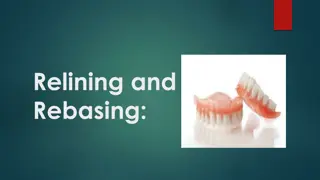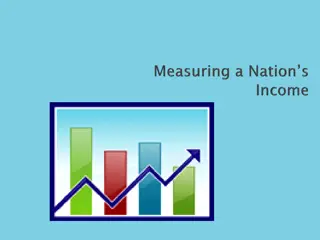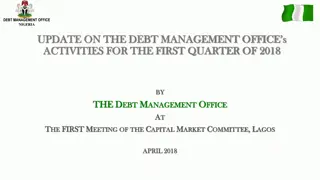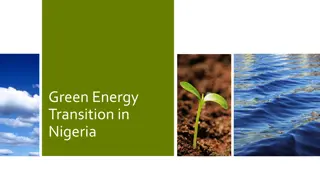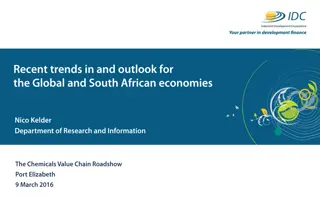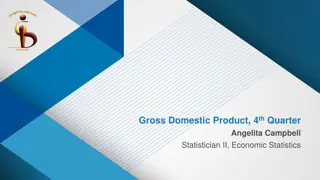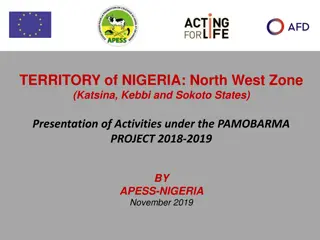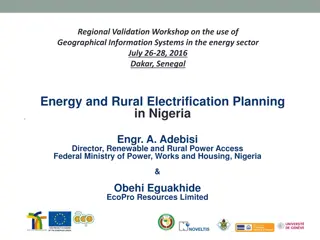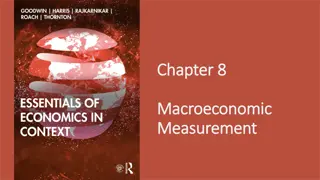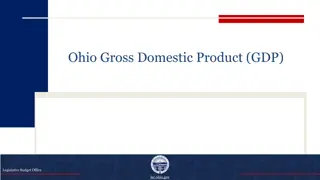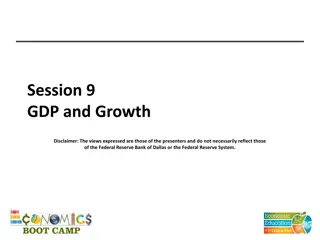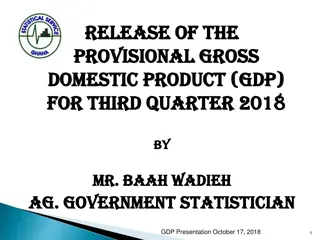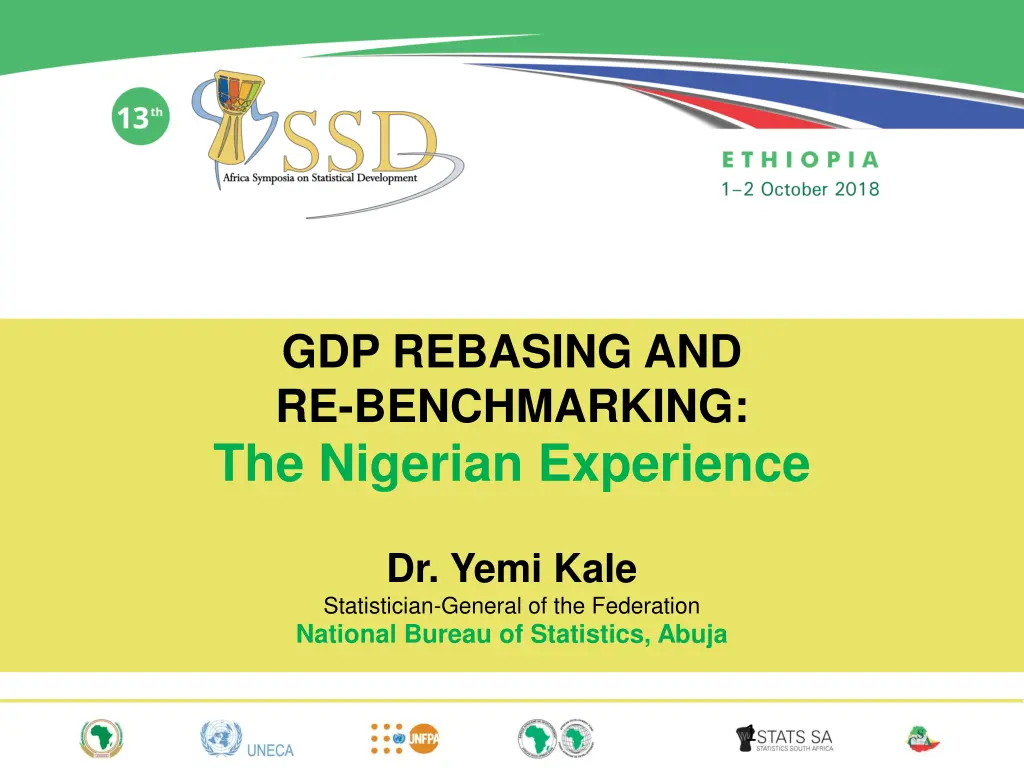
Nigerian GDP Rebasing and Re-benchmarking Experience
Explore the Nigerian GDP rebasing and re-benchmarking process led by Dr. Yemi Kale, the Statistician-General of the Federation. Discover the background, key results, lessons learned, and implications for policy issues. Gain insights into why GDP rebasing is important for understanding economic structures and making informed policy decisions.
Download Presentation

Please find below an Image/Link to download the presentation.
The content on the website is provided AS IS for your information and personal use only. It may not be sold, licensed, or shared on other websites without obtaining consent from the author. If you encounter any issues during the download, it is possible that the publisher has removed the file from their server.
You are allowed to download the files provided on this website for personal or commercial use, subject to the condition that they are used lawfully. All files are the property of their respective owners.
The content on the website is provided AS IS for your information and personal use only. It may not be sold, licensed, or shared on other websites without obtaining consent from the author.
E N D
Presentation Transcript
GDP REBASING AND RE-BENCHMARKING: The Nigerian Experience Dr. Yemi Kale Statistician-General of the Federation National Bureau of Statistics, Abuja 1
Contents Background Process Key results (and how it affected policy issues) Lessons learned Conclusion 2
Rebasing / re-benchmarking? Completed in 2014 with base year updated from 1990 to 2010 Economic activities increased from 33 to 46 Transition to SNA 2008 Rebasing - replacing the present price structure with a new or more recent price structure of the base year. This involves: Changing price and quantity base for individual price and quantity relatives Updating weights Re-benchmarking: involves incorporating those economic activities which were not in existence at the old base year, or were not being adequately captured within the GDP compilation framework 4
Why GDP rebasing / re-benchmarking? Economies are dynamic: growth, recession Over time, prices change and the structure of an economy changes introduction of new products alteration in the variety of products and services due to technological innovations and developments Changes in consumption Price structure of the economy changes base year structure becomes less representative of the economy as time progresses substitution effect: Consumers move away from relatively more expensive products to buy goods with relatively cheaper prices. 5
Key benefits Enables policy makers, analysts investors etc to obtain a more accurate picture and a better understanding of economic structure Inform policy decisions and program design System of National Accounts (SNA2008) recommends rebasing every 5 years but some countries keep the same base period for as many as 10 years or 5 years, and some changing the base period every year 6
Process 7
Country comparison of base year* 8 Number of years between base years 7 13 10 43 22 9 10 14 19 24 12 5 6 7 5 13 % Difference in GDP after rebasing -8.2 -10 9.9 -10.7 19.2 -4.4 11.7 70.0 2.5 ??? -11.6 25.6 10 9.8 10.5 -3.2 Country Old Base Year New Base Year Argentina Botswana Chile Guatemala Honduras Lesotho Morocco Nicaragua Niger Nigeria Paraguay Sierra Leone Tanzania Tunisia Uganda Venezuela 1986 1993 2006 1996 2001 2000 2004 1998 1994 2006 2010 1994 2006 2007 1997 2002 1997 1993/1994 1986 1958 1978 1995 1988 1980 1987 1990 1982 2001 2001 1990 1997/1998 1984 *as at April 2014 8
9Key activities undertaken Four major methodological pillars The System of National Accounts (SNA 2008 version), The International Standard Industrial Classification (ISIC Revision 4), The Central Product Classification (CPC version 2) The development of a Supply and Use Table/matrix (SUT) NBS conducted 14 sector surveys Additional data collected from various MDAs, and private businesses: FIRS, MoF, SEC,CBN, Customs, MAN, REDAN, NEITI, MTN, Validation by International and Domestic experts IMF, World Bank, ADB, 6 renowned economists 9
Sector surveys included: 8. Real Estate activities 9. Professional ,Scientific & Technical activities 10. Administrative & Support Service activities 11. Education 12. Human Health and Social Work activities 13. Arts & Entertainment 14. Other Service activities 1. Mining and Quarrying 2. Manufacturing 3. Construction 4. Wholesale & Retail Trade, Repair of motor vehicles & motor cycles 5. Transportation & Storage 6. Accommodation & Food service activities 7. Information & Communication 10
Additional administrative data collection Additional supplemental data gathering was conducted along with the FIRS and other MDAs They supplied data on: Electricity Gas, Steam & Air conditioning Supply Water Supply, Sewage, Waste Management and remediation activities Oil marketing activities 11
Updates to NBS survey frames The previous survey frame was merged with the list of establishments obtained from the Federal Inland Revenue Service (FIRS) In the end, a total of 851,628 establishments were in the frame compared to 83,733 The survey frame was then used for the sampling and selection of units 12
Key results 15
Key results Old Series (N, Million, Current Prices) 2010 2011 10,310,655.64 11,593,434.13 15,659,521.00 16,569,291.58 8,014,577.50 9,247,134.90 33,984,754.13 37,409,860.61 2012 2013F Nominal GDP (2013) est.: N80.1trillion Agriculture Industry Services TOTAL 13,413,842.46 16,456,457.10 10,673,800.38 40,544,099.94 14,709,104.92 15,374,554.67 12,313,106.11 42,396,765.71 New Series (N, Million, Current Prices) 2010 13,048,892.80 14,037,825.84 13,826,433.90 17,853,113.99 27,736,937.48 31,089,457.4 54,612,264.18 62,980,397.22 ~ US$509 billion 2011 2012 2013 Agriculture Industry Services TOTAL 15,815,997.51 19,587,721.32 36,310,216.23 71,713,935.06 16,816,553.01 20,853,845.33 42,422,165.04 80,092,563.38 Largest economy in Africa; 26th largest in the world by nominal GDP Percentage change between Old and New Estimates (%) 2010 2011 27% 21% -12% 8% 246% 236% 61% 68% 2012 18% 19% 240% 77% 2013 14% 36% 245% 89% Agriculture Industry Services TOTAL 16
Key results 17 A decline in the share of Agriculture... Nominal GDP by Sector, 2013 60.00% 50.00% decline in the share of Industry ... 40.00% 30.00% 20.00% but a rise in the share of Services... 10.00% 0.00% Agric 21.00% 34.69% Industry 26.04% 36.26% Services 52.97% 29.04% New Series Old Series 17
Key results Annual real GDP growth estimate was lower Real GDP Growth Old Series (%) New Series (%) 7.43 6.89 6.58 5.49 5.31 4.21 2011 2012 2013 18
Change in nominal GDP 2010 Current Prices (N trillion) 19 Telecommunications and Information Services TRADE MANUFACTURING REAL ESTATE Telecommunications sector recorded the largest positive revisions PROFESSIONAL, SCIENTIFIC AND TECHNICAL Crop Production PUBLIC ADMINISTRATION CONSTRUCTION Motion Pictures, Sound recording and Music ARTS, ENTERTAINMENT AND RECREATION Coal Mining Water Transport Metal Ores Rail Transport & Pipelines Fishing Crude Petroleum and Natural Gas Naira, Trillions -6 -4 -2 0 2 4 6 8 Two activities recorded downward revisions 19
% GDP 2013F, at 1990 prices Contribution to real GDP, 2013 (%) New real GDP: 2013 Rebased Series, (N, Trillion) 20 Crop Production Wholesale and Retail Crude Petroleum & Telecommunications Other Manufacturing Financial Institutions 34.13% Crop Production 20.96% 16.62% 11.24% 9.22% 8.57% 7.76% 4.65% 3.59% 3.58% 2.89% 2.52% 2.45% 2.02% 1.73% 1.63% 1.17% 0.97% 0.97% 0.86% 0.68% 0.60% 20.33% Crop Trade Crude 13.25 10.51 7.11 5.83 5.42 4.90 2.94 2.27 2.27 1.83 1.59 1.55 1.28 1.10 1.03 0.74 0.62 0.61 0.54 0.43 0.38 Trade 12.82% 8.10% 4.00% 3.12% 2.69% 2.52% 2.41% 2.35% 1.92% 1.30% 0.86% 0.61% 0.58% 0.50% 0.40% 0.22% 0.16% 0.16% 0.14% Crude Petroleum Manufacturing Telecommunicat Real Estate Food, Beverage Construction Professional, Manufacturi Telecommu Real Estate Food, Construction Professional, Public Financial Other Services Education Textile, Livestock Broadcasting Electricity Livestock Road Transport Building & Construction Public Financial Other Services Education Textile, Apparel Livestock Broadcasting Road Transport Motion Pictures, Accommodation Human Health Cement Real Estate Fishing Other Services Public Administration Hotel and Restaurants Forestry Road Motion Accommod Human Cement Quarrying & Other Education Water ...compared to only 3 activities in the old series Insurance Transport Services 6 activities constituted 70% of real GDP is now 6... 20
Key results 21 GDP by Sector: BRICS Comparison (2012) 100% Structural issues became more evident after rebasing 90% 80% 70% 60% Services 50% Manufacturing 40% Industry Agriculture 30% 20% 10% 0% Brazil Russia India China South Africa Nigeria Nigeria s service sector (purple section) compared well to that of BRICS countries, although agriculture (blue section) remained larger than all Sourc WDI 21
Key results 22 GDP by Sector: MINT Comparison (2012) 100% Structural issues became more evident after rebasing 90% 80% 70% 60% Services 50% Manufacturing Industry 40% Agriculture 30% 20% 10% 0% Mexico Indonesia Turkey Nigeria Nigeria had the largest agriculture sector (blue section) of the MINT but the smallest manufacturing sector (green section), although the new and larger services sector (in purple) was comparable Source: WDI 22
Key results 23
Financial and monetary ratios Commercial Banks' Total Loans and Advances (%GDP) Believed rising Old Series New Series 23.6 22.7 20.1 19.5 but stable 14.1 12.5 11.6 11.4 2010 2011 2012 2013 25
Financial and monetary ratios Believed rising Credit to Private Sector as % GDP Old Series New Series 37.22 36.13 but stable 29.89 28.50 23.96 20.43 19.70 16.93 2010 2011 2012 2013 26
Fiscal ratios Maintained trend Debt to GDP (%) Fiscal Deficit to GDP (%GDP) Old Series New Series Old Series New Series 23.69 3.25 3.10 20.26 18.63 17.76 2.41 2.09 2.02 1.84 12.54 12.03 11.05 10.53 1.36 1.11 2010 2011 2012 2013 2010 2011 2012 2013 27
Fiscal ratios Maintained trend Government Revenue to GDP (%) Federal Tax Revenue to GDP Old Series New Series Old Series New Series 22.69 22.31 22.02 12.37 12.35 11.33 8.35 13.88 13.47 7.35 12.45 6.98 6.00 5.20 2010 2011 2012 2013 2010 2011 2012 28
External sector ratios Maintained trend Current Account Surplus (% GDP) Total Exports to GDP Old Series New Series Old Series New Series 7.42 55.4 7.30 52.0 6.37 38.28 5.16 33.6 31.3 30.9 4.12 3.96 3.93 23.82 3.07 17.8 2010 2011 2012 2013 2010 2011 2012 2013 29
Income/welfare ratios Believed flat Per-Capita GDP Old Series New Series but higher and rising slowly 2908.08 2683.98 2490.05 2281.14 1539.39 1517.41 1479.07 1419.54 2010 2011 2012 2013 30
Social infrastructure spending Lower but maintained trend FGN Spending on Health FGN Spending on Education Old Series New Series Old Series New Series 0.73 1.00 0.99 0.98 0.60 0.76 0.50 0.43 0.59 0.39 0.55 0.53 0.34 0.47 0.27 0.25 2010 2011 2012 2013 2010 2011 2012 2013 31
33 Growth IS NOT development Nominal GDP and per capita GDP of top 10 economies, 2013 (IMF) Rank Country GDP USD trn$ Rank Country GDP US$ 1 United States 16.79 1 Qatar 98,814 2 China 9.18 2 Luxumbourg 78,670 3 Japan 4.9 3 Singaporre 64,584 4 Germany 3.63 4 Norway 54,947 5 France 2.73 5 Brunei 53,431 6 United Kingdom 2.53 6 United States 53,101 7 Brazil 2.24 7 Switzerland 46,430 8 Russia 2.11 8 Canada 43,472 9 Italy 2.07 9 Australia 43,073 10 India 1.87 10 Austria 42,597 26 Nigeria 0.5 121 Nigeria 2,689 Nominal GDP ranking improved but low per capita GDP remains a development challenge 33
Lessons for statistical system Inclusiveness & collaboration: o Relevant MDAs need to know that their input is key in data production to support policymaking; Consultation: o 4 international National Accounts consultants (including AfDB/IMF/WB) & 6 academics Transparency: o Documentation of work, sources and methods Communication: o Create public awareness and manage expectations 34
Conclusion 35
Conclusion Nigeria is already up to date in terms of: Conforming with SNA 2008 Using the latest guidelines (ISIC Rev 4.0 and CPC v.2) Additional data collection required to aid the rebasing of GDP from 2010 to 2017 National Living Standard Survey (NLSS) available in 2019 Sector surveys 36
There were challenges in the exercise: Significant changes led to need to explain why the constant GDP growth rates have been revised compared with those previously published Rather than: a routine statistical exercise Previously favourable ratios became less favourable Low statistical literacy among the general public resulting in some speculation about motives Special financing was required. But the three most lasting impacts on the NSS: an excellent learning opportunity strengthened statistical capacity & coordination improved sector policy intervention and targeting 37
THANK YOU 39



